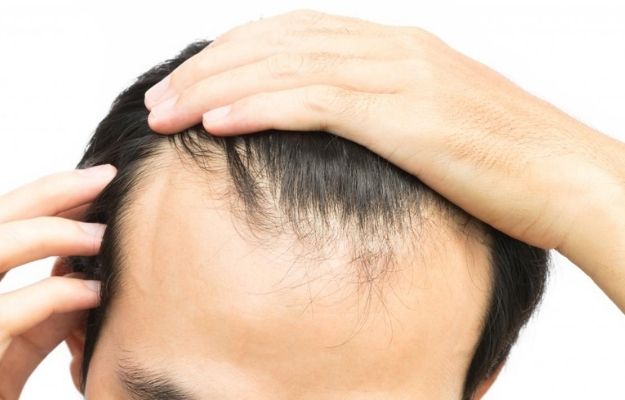
Health Hormone Health

Receding hairline, thinning hair, and patchy bald areas are a common concern among men. Although not life-threatening, hair loss causes psychological distress to men and dramatically affects one’s confidence. Fortunately, you have absolute control in preventing and managing your hair health. Read on to know more.
RELATED: Male Depression – How to Get Back to Feeling Like Yourself Again

Androgenetic alopecia, also known as male-pattern baldness, is the most common type of hair loss that affects 50% of males over 40. Two main factors can cause a receding hairline in men:
Family History
Hereditary condition that comes with aging is the common cause of hair loss. You are more likely to develop male-pattern baldness if this condition runs in the family. This happens gradually in predictable patterns such as receding hairline and bald spots.
Lifestyle
Environmental factors such as poor nutrition, smoking, and high-stress levels may contribute to hair loss.
Some men experience early-stage baldness as early as in their 20s, which progresses eventually with aging. Male pattern baldness usually progresses in distinct steps. The first sign is a receding hairline that usually progresses into a distinct M shape. After this, the hair on the head’s top or back usually begins to fall out, leaving a bald spot.
RELATED: Have You Lost Your Edge? How to Feel Better Again

Preventive measures can be used to manage hair loss in its early stages. This includes using proper hair products, avoiding smoking, taking supplements, and protecting your hair from UV and sunlight.
While receding hairline in men can be caused by hereditary factors, which are often irreversible, there are some tips you can do to slow down the hair loss process. Other options also include medical procedures that may effectively encourage hair regrowth.
Essential oils are concentrated compounds extracted from different plants’ scent, flavor, and medicinal properties.
While commonly used in aromatherapy, essential oils may also aid in hair growth. These extracts are mixed with a carrier oil such as coconut, jojoba, olive, and argan oil for scalp massage. Essential oils such as lavender oil may generate faster hair growth in an experiment conducted in mice. It also has antimicrobial and antibacterial properties that promote hair health.
Other essential oils you can use are peppermint and rosemary oil. In a separate study, peppermint oil showed hair growth effects, a significant increase in dermal thickness, follicle number, and follicle depth without toxic signs. Rosemary oil also provided a similar beneficial effect as minoxidil, a common drug for hair growth but with less scalp itching as a side effect.
Proper nutrition is just as important for hair growth as in overall health. Deficiency in protein, nutrients, vitamins, and minerals has shown to contribute to hair loss.
Consuming food with high nutritional value is essential to slow down hair loss and receding hairline. Foods high in vitamins A, B, C, D, iron, selenium, and zinc are vital to hair health. Moreover, since hair follicles are made up of a protein called keratin, protein-rich foods such as eggs, soy, meat, and dairy products may aid in optimum hair growth.
Severe stress is associated with hair loss, specifically alopecia areata, a condition that causes hair to fall out in small patches. This happens when the body is under chronic stress, and its immune system attacks the hair follicles — causing hair loss.
Meditation, physical exercises, and getting quality sleep are some of the ways you can manage stress.
Several over-the-counter and prescription drugs for hair loss are available such as minoxidil (Rogaine) and Finasteride (Propecia) that treat hair loss in men and enlarged prostate.
Always consult your doctor before taking any medications to avoid complications and unforeseen side effects.
PRP Hair Restoration
PRP (platelet-rich plasma) therapy is a relatively modern non-surgical treatment for hair loss or balding. This procedure involves drawing a patient’s blood, which is processed to separate blood components and achieve rich plasma concentration. This plasma-rich layer is injected into the patient’s scalp to stimulate hair growth in the balding area.
PRP therapy is proven to have a positive effect on hair density, thickness, and hair count, as shown through multiple clinical trials.
A hair transplant is an invasive procedure for dealing with hair loss. It mainly involves taking existing hair from thicker parts of your scalp or the body and then transferring it to the scalp’s thinning or balding spots. This whole procedure takes about four to eight hours, where you will receive a local anesthetic or request a sedative to stay asleep during the procedure.
Low-level Light Therapy (LLLT) is a safe, effective, and less invasive option for hair loss. It works by irradiating photons deep into scalp tissues. These photons are absorbed and stimulate cellular activity in the follicles to slow down hair loss and encourage regrowth.
Receding hairline could be a sign of early-stage baldness. Hair loss in men is usually caused by hereditary factors, which could be accelerated by lifestyle and health conditions. You can manage your hair health through self-care, medications, and non-invasive medical procedures.
Hair Loss can be caused by underlying health issues. Let us know how we can help you regain confidence and vitality. Opt Health offers personalized support from top-tier health experts. Contact us today to schedule a consultation.
Up Next:
Your health, your terms. Discover how personalized care can transform not just the way you feel, but how you live.